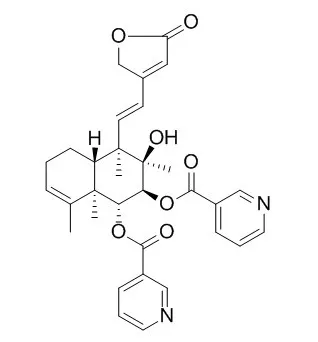| Description: |
Scutebarbatine A shows significant antitumor effects on A549 cells in vivo and in vitro via mitochondria-mediated apoptosis by up-regulating expressions of caspase-3 and 9, and down-regulating Bcl-2. Scutebarbatine A and barbatine A show a significant ability to protect cells against H2O2 with ED50 values of 5.0 and 16.8 uM, respectively. |
| Targets: |
Caspase | Bcl-2/Bax |
| In vitro: |
| Molecules. 2014 Jun 25;19(7):8740-51. | | In vitro and in vivo antitumor activity of scutebarbatine A on human lung carcinoma A549 cell lines.[Pubmed: 24968330] | During our systematic study on the anticancer activities of Scutellaria barbata, Scutebarbatine A (SBT-A), one of the major alkaloids in S. barbata, was found to have antitumor effects on A549 cells. Thus, we designed the present study to investigate in detail the antitumor effects of Scutebarbatine A .
METHODS AND RESULTS:
The cytotoxic effect of Scutebarbatine A on A549 in vitro were determined by an MTT assay and evaluated by IC50 values. Furthermore, results of Hoechst 33258 and Annexin V/PI staining assays demonstrated that Scutebarbatine A had significant antitumor effects on A549 cells via apoptosis, in a concentration-dependent manner. What's more, the mechanism was explored by western blotting, and our study revealed that Scutebarbatine A can up-regulate the expressions of cytochrome c, caspase-3 and 9, and down-regulate the levels of Bcl-2 in A549 cells. Finally, the antitumor effects of Scutebarbatine A were evaluated in vivo by using transplanted tumor nude mice, and the results confirmed that Scutebarbatine A has a notable antitumor effect on A549 cancer via mitochondria-mediated apoptosis.
CONCLUSIONS:
Collectively, our results demonstrated that Scutebarbatine A showed significant antitumor effects on A549 cells in vivo and in vitro via mitochondria-mediated apoptosis by up-regulating expressions of caspase-3 and 9, and down-regulating Bcl-2. |
|
| In vivo: |
| Oxid Med Cell Longev . 2015;2015:843721. | | Ginsenoside Rb1 Treatment Attenuates Pulmonary Inflammatory Cytokine Release and Tissue Injury following Intestinal Ischemia Reperfusion Injury in Mice[Pubmed: 26161243] | | Abstract
Objective. Intestinal ischemia reperfusion (II/R) injury plays a critical role in remote organ dysfunction, such as lung injury, which is associated with nuclear factor erythroid 2-related factor 2 (Nrf2)/heme oxygenase-1 (HO-1) signaling pathway. In the present study, we tested whether ginsenoside Rb1 attenuated II/R induced lung injury by Nrf2/HO-1 pathway. Methods. II/R injury was induced in male C57BL/6J mice by 45 min of superior mesenteric artery (SMA) occlusion followed by 2 hours of reperfusion. Ginsenoside Rb1 was administrated prior to reperfusion with or without ATRA (all-transretinoic acid, the inhibitor of Nrf2/ARE signaling pathway) administration before II/R. Results. II/R induced lung histological injury, which is accompanied with increased levels of malondialdehyde (MDA), interleukin- (IL-) 6, and tumor necrosis factor- (TNF-) α but decreased levels of superoxide dismutase (SOD) and IL-10 in the lung tissues. Ginsenoside Rb1 reduced lung histological injury and the levels of TNF-α and MDA, as well as wet/dry weight ratio. Interestingly, the increased Nrf2 and HO-1 expression induced by II/R in the lung tissues was promoted by ginsenoside Rb1 treatment. All these changes could be inhibited or prevented by ATRA. Conclusion. Ginsenoside Rb1 is capable of ameliorating II/R induced lung injuries by activating Nrf2/HO-1 pathway. |
|






 Cell. 2018 Jan 11;172(1-2):249-261.e12. doi: 10.1016/j.cell.2017.12.019.IF=36.216(2019)
Cell. 2018 Jan 11;172(1-2):249-261.e12. doi: 10.1016/j.cell.2017.12.019.IF=36.216(2019) Cell Metab. 2020 Mar 3;31(3):534-548.e5. doi: 10.1016/j.cmet.2020.01.002.IF=22.415(2019)
Cell Metab. 2020 Mar 3;31(3):534-548.e5. doi: 10.1016/j.cmet.2020.01.002.IF=22.415(2019) Mol Cell. 2017 Nov 16;68(4):673-685.e6. doi: 10.1016/j.molcel.2017.10.022.IF=14.548(2019)
Mol Cell. 2017 Nov 16;68(4):673-685.e6. doi: 10.1016/j.molcel.2017.10.022.IF=14.548(2019)